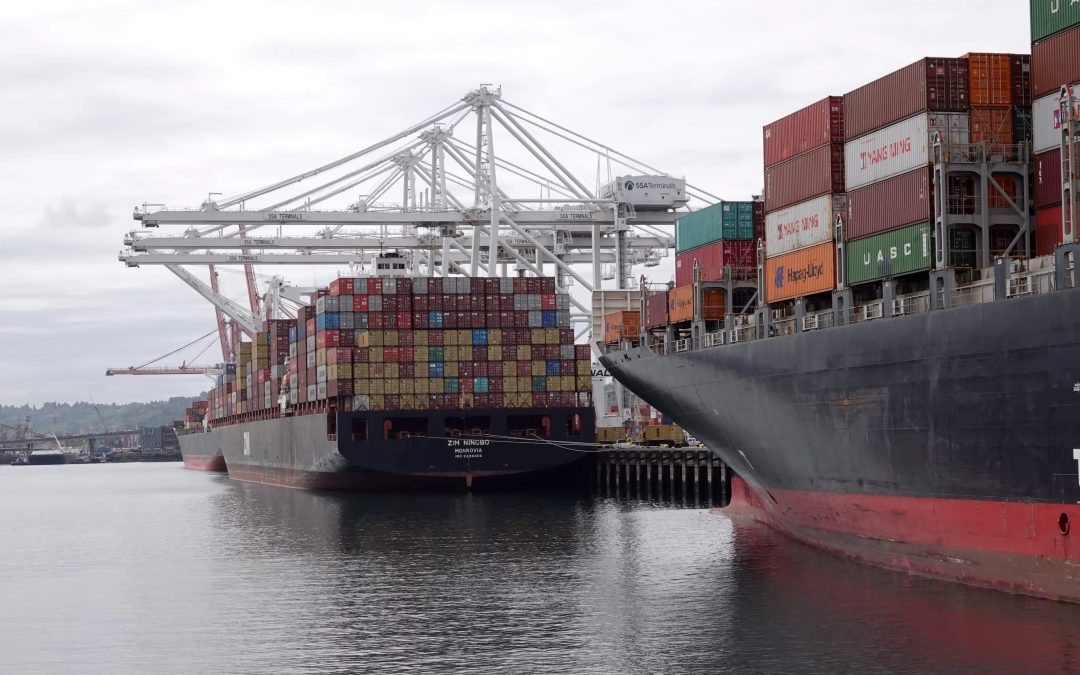Tensions are rising in West Coast port labor battles as unions and port management trade accusations about worker productivity and the awarding of job assignments.
The International Longshore and Warehouse Union has been accused of using slowdown tactics that have reduced cargo handling, according to a report in trade publication JOC.
The finger-pointing comes at a time when labor negotiations between the ILWU and the Pacific Maritime Association (which represents the terminals and ocean carriers) are about to enter a fourth month. Dockworkers have been working without a contract since July.
According to the report, the slowdown resulted in reduced productivity at the Oakland and Seattle-Tacoma ports, but according to the CNBC Supply Chain Heat Map, operations at these ports have been in line with the ports’ recent productivity and there have been no significant cargo handling issues recorded.
The CNBC Supply Chain Heat Map receives data on the daily productivity of ports ranging from vessel anchorage, vessel time in port, the wait time for import and export containers in terminals, as well as rail wait times, and truck pickups.
Officials at the Port of Seattle-Tacoma told CNBC that last week there was a small number of picketers at Seattle’s Terminal 5 protesting the terminal over using the Machinists Union instead of the ILWU to perform “cold ironing”, a process where ships can use shore power while docked. CNBC was told the vessel operation was idled for one shift and the issue was resolved. The terminal is used by SSA Marine.
“Operations in The Northwest Seaport Alliance gateway are running smoothly with terminals in Seattle and Tacoma operating at normal levels of productivity,” said John Wolfe, chief executive officer of The Northwest Seaport Alliance.
Jerome Roberts, GVP of marketing at supply chain consulting company Blume Global, told CNBC the one shift protest had no lasting productivity impact.
“The data collected by our platform has consistently shown vessel turnaround time and dwell time have shown no meaningful shift in direction,” said Roberts. “Over the last few weeks, it appears productivity and port activity has been consistent respectively across the ports at Oakland, Seattle, Long Beach, and even Los Angeles, which recently had a labor slowdown.”
“The ILWU is working and negotiating, and we’ve done both successfully for nearly 90 years” said ILWU Coast Committeeman Cameron Williams. “Unfounded rumors are rampant during negotiations, and it’s unfortunate that some media publish opinions instead of facts.”
Meanwhile, the ILWU claims that SSA Marine, a member of the Pacific Maritime Association, “circumvented the assignment of work” by having the National Labor Relations Board get involved and award the cold ironing jobs to another union, work that should have gone to their members according to contract terms.
“We are shocked that SSA is taking such an action, and we are currently regrouping to determine how to proceed in negotiations while we watch an employer violate the very provision of the contract over which the parties were bargaining,” Williams said.
A spokesperson for SSA declined to comment and referred all questions to the PMA, which did not respond to requests for comment.
Logistics companies fear the latest round of accusations will only increase tensions for a supply chain and national port infrastructure already dealing with multiple labor concerns.
The Port of Los Angeles diverted 40,000 containers to the Port of Long Beach in August when dockworkers at the Port of LA refused to work at the automated section of APM Terminals, the largest container-handling facility citing safety concerns. APM is a part of A.P. Moeller-Maersk A/S and the automation part of the terminal has been operating since 2020. Workers did not work at that facility for nearly four weeks.
That diversion of containers to Long Beach, in addition to the continued re-routing of containers to the East Coast, led to the Port of New York to take the No. 1 spot in processing import and export containers in August. Port of Los Angeles fell to third.
Project44, which also collects and analyzes port productivity for the CNBC Supply Chain Heat Map, has tracked some recent issues at Seattle operations.
Container dwell times at the Port of Oakland have been improving over the month of September, according to Josh Brazil, vice president of supply chain insights at Project44. Containers that used to dwell for eight or more days are now waiting four to five days on average. But Seattle operations are experiencing heightened export dwell times, currently at 11 days. That is up 83% from the previous 6-day average at the beginning of the month. “The general outlook is that it seems to be business as usual in terms of dwell times, except for Seattle’s exports,” Brazil said.
Export delays out of the Pacific Northwest are one challenge that U.S. farm exporters have been experiencing. One U.S. logistics manager recently told CNBC they were avoiding the Seattle/Tacoma Port by using the UP to Norfolk Southern rail route to the Port of Virginia where their cargo was loaded on a Hapag Lloyd vessel.
Source: Hellenic Shipping News






